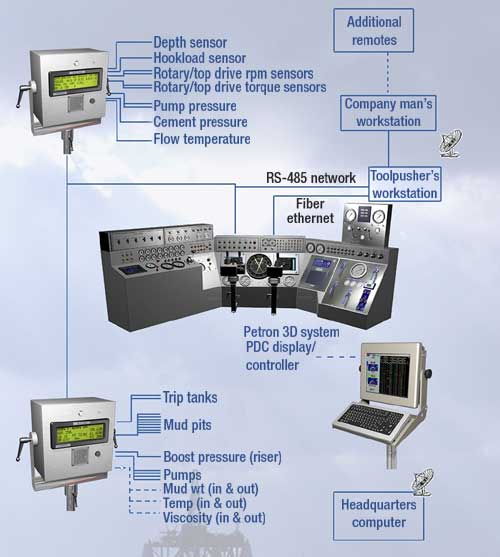| Vol. 227 No. 12 |
 |
Rig floor equipment
Distributed drilling data system covers drilling workflow
Petron Industries Inc. presents new technology with its Distributed Drilling Data (3D) Instrumentation System that embraces the drilling rig’s total workflow. The networked drilling data acquisition system is modular in design, with open architecture and versatile display configurations.
The system’s basis is the smart sensor data hub concept. Local data collection units are close to the sensor hub areas (i.e. pit area, drill floor, etc.). These smart data hubs include integral Man Machine Interface (MMI) which allows local display of sensor data, local calibration of the data acquisition unit and manual drilling information entry. The data hubs are controlled from the master display unit, located at the driller’s station. The system supports many slave or passive displays.
Rig floor 3D system control stations and rig floor slave displays may be either a high-bright-color, touch-screen LCD units and/or large character LCD units. The rig office connection to the system is a PC-based workstation running Petron Net Technologies (PNT) software, which provides the user with data display, data archiving, off-rig connectivity and drilling engineering applications. This architecture allows system configurations from a simple electronic-drilling recorder to an advanced drilling information system with Internet or Intranet connectivity.
 |
Petron’s Distributed Drilling Data (3D) Instrumentation System embraces the drilling rig’s total workflow.
|
|
The electronic hardware is a 15-in., high-bright LCD, color, flat-panel display with integral touch screen and a high-performance embedded computer. The computerized display panel uses RS-485 and Ethernet connectivity to exchange data throughout the system. This panel is housed in a NEMA 4X, environmentally-sealed enclosure, which is certified for hazardous environment use without a purge system.
PNT software integrates into and extends the power of the system. The user can access data in familiar, ready-to-use formats (e.g. real-time drum recorder charts, real-time logs and numerous numeric, graphic and combination screens). If detailed or custom data presentation is a requirement, PNT can do it. System navigation has never been a problem – the PNT control panel is one click away and then one click to any other PNT component. Petron has paid special attention to the hardware platform, including redundant hard drives, high speed Intel processors and high capacity removable media.
Dril Net is the direct Internet connection to the rig site for up-to-date drilling information. All drilling information is hosted directly from the rig without being relayed through a third-party, Internet portal. Remote access and viewing does not affect the operation of the information system. When complete data files are required, containing more detailed drilling information, Dril Net can quickly access and download them using Petron Office software, or export files to other applications.
Dril Net SP, a portal solution, has the capability to integrate the drilling information of many wells in one secure site. Real-time drilling data is transmitted via satellite to the Petron Dril Net SP. The drilling data is stored to the portal database, which allows information viewing from online wells and historical data from completed wells. Online access to historical and real-time, well-drilling information streamlines decision-making during well planning and drilling.
The system’s Drill Data Hub (DDH) is a networked drilling data acquisition device designed for the collection and transmission of drilling data in the drilling rig environment. This unit uses Petron’s rugged, rig-proven, single-board design. The DDH has an integral HMI that allows for local calibration and troubleshooting without an auxiliary laptop computer or terminal. The DDH converts the signals from the sensors in the drillfloor area to a system-compatible data stream. The typical drilling parameters provided are depth, bit location, ROP, pipe velocity, rotary rpm and torque, top drive rpm and torque, pump pressure, casing pressure, flow, drilling gas, mud weight out and temperature out.
The Pump and Pit Data Hub provides the same advantages in electronic and mechanical design as the DDH, but the software interfaces with the sensors at the pit and pump area. Typical drilling parameters transmitted are total pump output (gpm), SPM1, SPM2, SPM3, SPM4, total strokes1, total strokes2, total strokes3, total strokes4, mud pits 1-10, trip tanks 1-2, mud temperature in and mud weight in. This unit also allows manual entry of mud weight and mud viscosity data.
Forward industry trends indicate that data monitoring and recording may be required for bulk storage systems, pumps, generators, drive mechanisms and other key systems on the rig. Petron’s 3D system design and open architecture allows for expansion when these additions are required. The system’s data server can merge the data from PLCs, WITS data streams, third-party drilling services and Petron Data Hubs.
Petron’s 3D Instrumentation System facilitates faster decision making, promotes employee collaboration and reduces redundancy by distributing data when and where it is required. By making knowledge distribution and expertise exchange between office and rig site(s) rapid and timely, Petron improves productivity, extends equipment life, improves safety and reduces administrative overhead. 
|




